
of many of them must have been fifty or sixty
feet, at least.*
Count Sternberg has applied the name Syrin-
godendron to many species of Sigillaria, from the
parallel pipe-shaped flutings that extend from
the top to the bottom of their trunks. These
trunks are without joints, and many of them
attain the size of forest trees. The flutings on
their surface bear dot-like, or linear impressions,
of various figures, marking the points at which
the leaves were inserted into the stem. This
fluted portion of the Sigillarise, formed their external
covering, separable like true bark from
the soft internal axis, or pulpy trunk; it varied
in thickness from an inch to one-eighth of an
inch, and is usually converted into pure coal.
(See PI. 56, Fig. 2. a, b, c.)
A fleshy trunk surrounded and strengthened
only by such thin bark, must have been incapable
of supporting large and heavy branches
at its summit. It therefore probably terminated
abruptly at the top, like many of the larger
species of living Cactus, and the abundant disposition
of small leaves around the entire extent
of the trunk seems to favour this hypothesis.
* M. Ad. Brongniart found in a coal mine in Westphalia near
Essen, the compressed stem of a Sigillaria laid horizontally, to
the length of forty fe et; it was about twelve inches in diameter
at its lower, and six inches at its upper extremity, where it divided
into two parts, each four inches in diameter. The lower
end was broken off abruptly. Lindley and Hutton’s Foss. Flora,
The impressions, or scars, which formed the
articulations of leaves on the longitudinal flutings
of the trunks of Sigillariæ, are disposed in vertical
rows on the centre of each fluting from the
top to the bottom of the trunk. Each of these
scars marks the place from which a leaf has
fallen off, and exhibits usually two apeftures, by
which bundles of vessels passed through the
bark to connect the leaves with the axis of the
tree. No leaf has yet been found attached to
any of these trunks ; we are therefore left entirely
to conjecture as to what their nature may have
been. This non-occurrence of a single leaf upon
any one of the many thousand trunks that have
come under observation, leads us to infer that
every leaf was separated from its articulation,
and that many of them perhaps, like the fleshy
interior of the stems, had undergone decomposition,
during the interval in which they were
floating between their place of growth, and that
of their final submersion.
M. Ad. Brongniart enumerates forty-two species
of Sigillaria, and considers them to have been
nearly allied to arborescent Ferns, with leaves
very small in proportion to the size of the stems,
and differently disposed from those of any living
Ferns. He would refer to these stems many of
the numerous fern leaves of unknown species,
which resemble those of existing arborescent
genera of this family. Lindley and Hutton shew
strong reasons for considering that Sigillarise